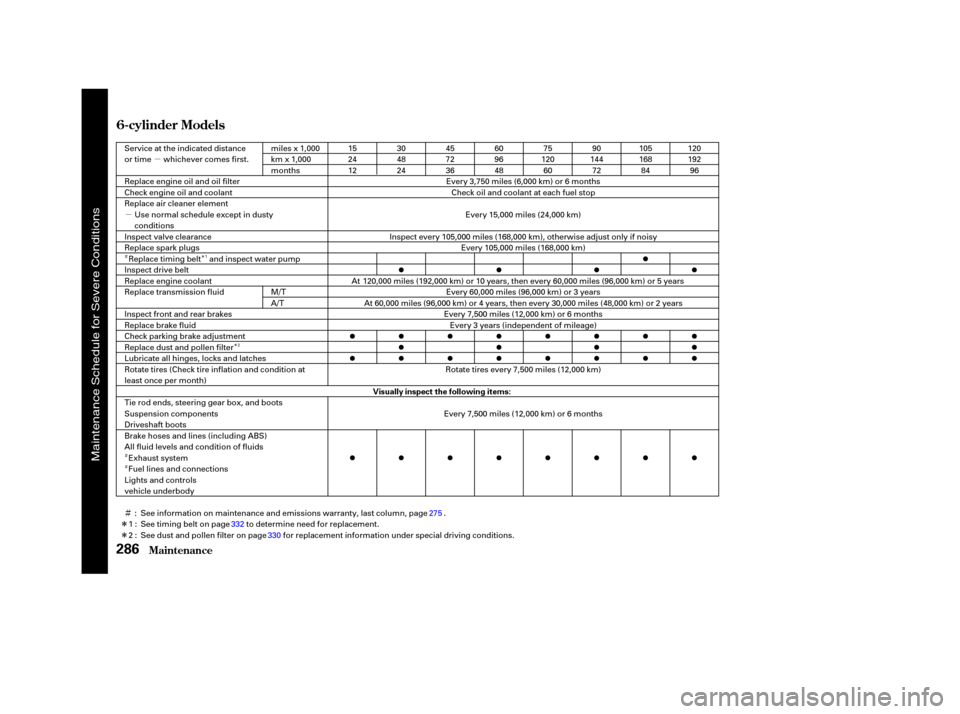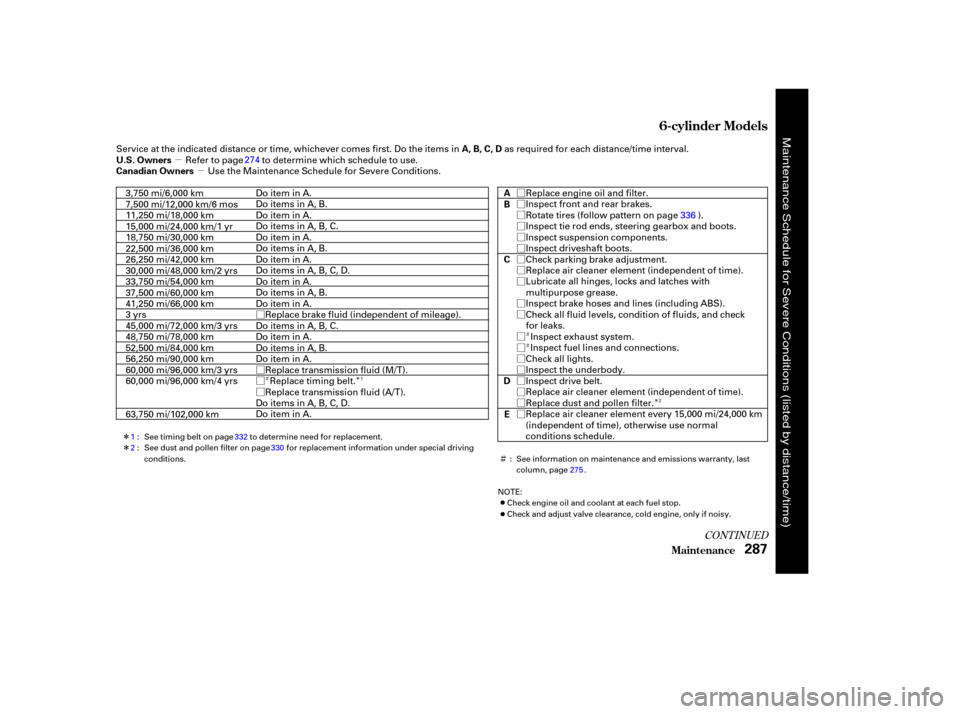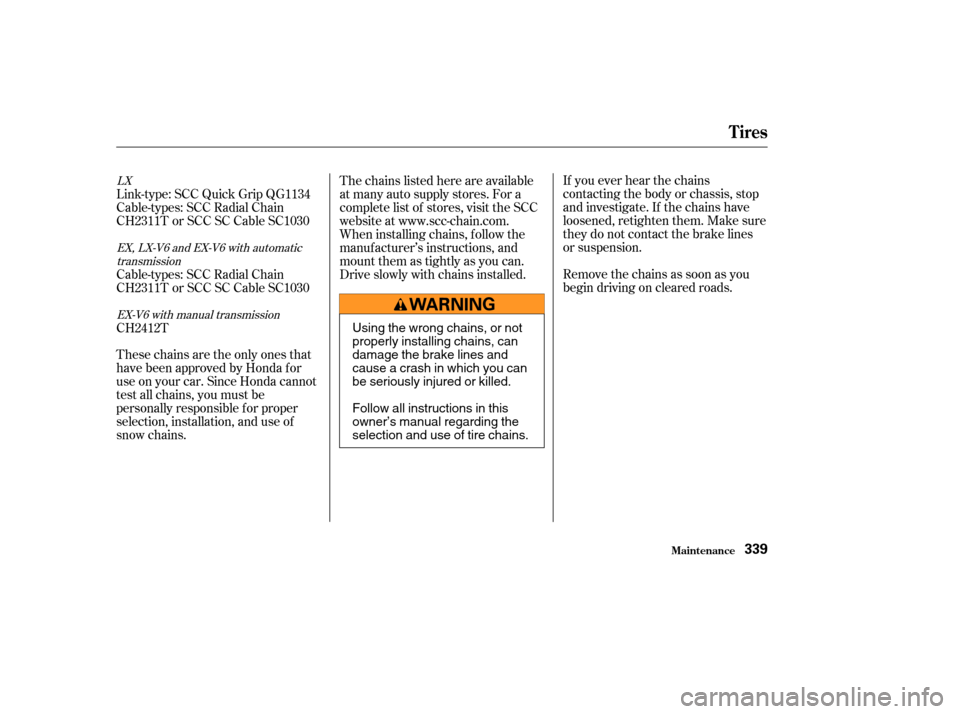Page 289 of 429

�µ
�µ
�Ì
�Î
�Î
�Ì
�Ì �Ì�Î
�Î
6-cylinder Models
Maint enance286
Visually inspect the following items:
Service at the indicated distance
or time whichever comes first.
miles x 1,000
km x 1,000
months
Every 3,750 miles (6,000 km) or 6 monthsCheck oil and coolant at each fuel stop
Inspect every 105,000 miles (168,000 km), otherwise adjust only if noisy Every 15,000 miles (24,000 km)
Every 105,000 miles (168,000 km)
120,000 miles (192,000 km) or 10 years, then every 60,000 miles (96,000 km) or 5 years
See dust and pollen filter on page for replacement information under special driving conditions. See timing belt on page to determine need for replacement.
See information on maintenance and emissions warranty, last column, page .
Tie rod ends, steering gear box, and boots
Suspension components
Driveshaft boots
Brake hoses and lines (including ABS)
All fluid levels and condition of fluids
Exhaust system
Fuel lines and connections
Lights and controls
vehicle underbody Every 7,500 miles (12,000 km) or 6 months
Rotate tires every 7,500 miles (12,000 km)
Replace engine oil and oil filter
Check engine oil and coolant
Replace air cleaner element
Use normal schedule except in dusty
conditions
Inspect valve clearance
Replace spark plugs Replace timing belt and inspect water pump
Inspect drive belt
Replace engine coolant
Replace transmission fluid
Inspect front and rear brakes
Replace brake fluid
Check parking brake adjustment
Replace dust and pollen filter
Lubricate all hinges, locks and latches
Rotate tires (Check tire inflation and condition at
least once per month) Every 3 years (independent of mileage)
Every 7,500 miles (12,000 km) or 6 months
At 60,000 miles (96,000 km) or 4 years, then every 30,000 miles (48,000 km) or 2 years 30
48
24
15
24
12 45
72
3675
120 60 105
168
84
90
144 72
Every 60,000 miles (96,000 km) or 3 years 60
96
48
120
192
96
At
:
1:
2: 275
332 330M/T
A/T
1
2
Maintenance Schedule for Severe Conditions
Page 290 of 429

�µ
�µ
�Ø
�Ø
�Ø
�Ø �Ø
�Ø
�Ø
�Ø
�Ø
�Ø
�Ø
�Ø
�Ø
�Ø
�Ø
�Ø
�Ø
�Ø
�Ø
�Ø
�Ø
�Ø
�Ø
�Ì�Î
�Ì
�Ì
�Î
�Ì
�Î
�Î
CONT INUED
Maint enance
6-cylinder Models
287
Canadian Owners U.S. Owners
A, B, C, D
AB
C
D E
Use the Maintenance Schedule for Severe Conditions.
Refer to page to determine which schedule to use.
Service at the indicated distance or time, whichever comes first. Do the items in as required for each distance/time interval.
3,750 mi/6,000 km
7,500 mi/12,000 km/6 mos
11,250 mi/18,000 km
15,000 mi/24,000 km/1 yr
18,750 mi/30,000 km
22,500 mi/36,000 km
26,250 mi/42,000 km
30,000 mi/48,000 km/2 yrs
33,750 mi/54,000 km
37,500 mi/60,000 km
41,250 mi/66,000 km
3yrs
45,000 mi/72,000 km/3 yrs
48,750 mi/78,000 km
52,500 mi/84,000 km
56,250 mi/90,000 km
60,000 mi/96,000 km/3 yrs
60,000 mi/96,000 km/4 yrs
63,750 mi/102,000 km Do item in A.
Do items in A, B.
Do item in A.
DoitemsinA,B,C.
Do item in A.
Do items in A, B.
Do item in A.
DoitemsinA,B,C,D.
Do item in A.
Do items in A, B.
Do item in A.
Replace brake fluid (independent of mileage).
DoitemsinA,B,C.
Do item in A.
Do items in A, B.
Do item in A. Replace transmission fluid (M/T).Replace timing belt.
Replace transmission fluid (A/T).
DoitemsinA,B,C,D.
Do item in A. Replace engine oil and filter.
Inspect front and rear brakes.
Rotate tires (follow pattern on page
336).
Inspect tie rod ends, steering gearbox and boots.
Inspect suspension components.
Inspect driveshaft boots.
Check parking brake adjustment.
Replace air cleaner element (independent of time).
Lubricate all hinges, locks and latches with
multipurpose grease.
Inspect brake hoses and lines (including ABS).
Check all fluid levels, condition of fluids, and check
for leaks. Inspect exhaust system.
Inspect fuel lines and connections.
Check all lights.
Inspect the underbody.
Inspect drive belt.
Replace air cleaner element (independent of time).
Replace dust and pollen filter.
Replace air cleaner element every 15,000 mi/24,000 km
(independent of time), otherwise use normal
conditions schedule.
274
1
2
See dust and pollen filter on page for replacement information under special driving
conditions. See timing belt on page to determine need for replacement.See information on maintenance and emissions warranty, last
column, page .
Check engine oil and coolant at each fuel stop.
Check and adjust valve clearance, cold engine, only if noisy.
NOTE: :
1:
2:
332
330
275
Maintenance Schedule for Severe Conditions (listed by distance/time)
Page 342 of 429

If you ever hear the chains
contacting the body or chassis, stop
and investigate. If the chains have
loosened, retighten them. Make sure
they do not contact the brake lines
or suspension.
Removethechainsassoonasyou
begin driving on cleared roads.
Link-type: SCC Quick Grip QG1134
Cable-types: SCC Radial Chain
CH2311T or SCC SC Cable SC1030
The chains listed here are available
at many auto supply stores. For a
complete list of stores, visit the SCC
website at www.scc-chain.com.
When installing chains, f ollow the
manuf acturer’s instructions, and
mount them as tightly as you can.
Drive slowly with chains installed.
Thesechainsaretheonlyonesthat
have been approved by Honda f or
use on your car. Since Honda cannot
test all chains, you must be
personally responsible f or proper
selection, installation, and use of
snow chains. Cable-types: SCC Radial Chain
CH2311T or SCC SC Cable SC1030
CH2412TLX EX, LX-V6 and EX-V6 with automatictransmission
EX-V6 with manual transmission
Tires
Maint enance339
Using the wrong chains, or not
properly installing chains, can
damage the brake lines and
cause a crash in which you can
be seriously injured or killed.
Follow all instructions in this
owner’s manual regarding the
selection and use of tire chains.
Page 394 of 429

�µ�µ �µ
There are three popular types of
prof essional towing equipment. The operator
loads your car on the back of a truck.
The tow
truck uses two pivoting arms that go
under the tires (f ront or rear) and lif t
them of f the ground. The other two
tires remain on the ground. The tow
truck uses metal cables with hooks
on the ends. These hooks go around
parts of the f rame or suspension and
the cables lif t that end of the car of f
the ground. Your car’s suspension
and body can be seriously damaged.
If your Honda cannot be transported
by f lat-bed, it should be towed by
wheel-lif t equipment with the f ront
wheels of f the ground. If due to
damage, your car must be towed
with the f ront wheels on the ground,
do the f ollowing:
Release the parking brake.
Shif t the transmission to Neutral.
If your car needs to be towed, call a
prof essional towing service or, if you
belong to one, an organization that
provides roadside assistance. Never
tow your car behind another vehicle
with just a rope or chain. It is very
dangerous.
Release the parking brake.
Start the engine.
ShifttoD,thentoN.
Turn of f the engine.
With the f ront wheels on the ground,
it is best to tow the car no farther
than 50 miles (80 km), and keep the
speedbelow35mph(55km/h).
If your car is equipped with a f ront
spoiler, remove it bef ore towing so it
is not damaged.
Manual Transmission: Automatic Transmission:
CONT INUED
Flat -bed Equipment
Wheel-lif t Equipment Sling-t ype Equipment
This is the best way to transport
your Honda.
T his is
an acceptable way to tow your
Honda. T his method of towing is
unacceptable.
Emergency T owing
T aking Care of t he Unexpect ed391
Improper towing preparation will
damage the transmission. Follow the
above procedure exactly. If you cannot
shif t the transmission or start the
engine (automatic transmission), your
car must be transported with the f ront
wheels of f the ground.